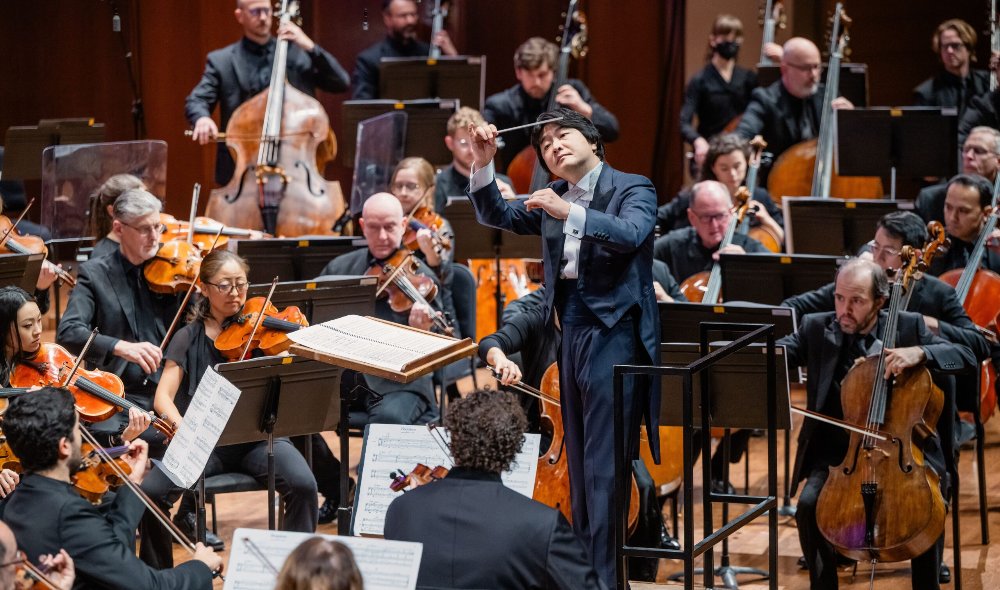Seattle Symphony’s performance of November 23 opened with an imaginative idea. At first glance, placing the Requiems of the expressionistic Toru Takemitsu and the impressionistic Gabriel Fauré one after another on the program might have seemed an incompatible program pairing. However, both works share a similar concept, to downplay the fear and fury of Judgment Day and focus more on the spiritually restful and comforting meaning of “requiem” itself. Thus, in spite of the 70 years between their composition dates and the inevitable contrasts in musical style, they combined to make an effective and moving first half of the evening’s entertainment. And this success was largely due to Kazuki Yamada’s understated manner as conductor.
The Requiem for string orchestra, composed in 1957, was one of the prolific Takemitsu’s early successes. It was Stravinsky’s extravagant praise, “a masterpiece” he proclaimed, that helped launch Takemitsu’s career in the West. It is a requiem without words, where the thematic risings and fallings of the string orchestra evoke lamenting voices, harmonic sighs punctuated with dissonant outbursts.
Still, it is curiously serene in its short and taut way, a fine balance between the lush and the astringent. The orchestra’s strings captured this dichotomy superbly well, sweeping from moments of homophonic richness to punctuated sul ponticello (“on the bridge”) raspiness with ease. Principal violist Sayaka Kobuko’s contemplative solo that briefly emerged from the plush texture was particularly moving. Yamada kept it all emotionally restrained with virtually no exaggerations of tempi or gesture, never letting the underlying bitterness of Takemitsu’s sorrow over the loss of his mentor Fumio Hayasaka overwhelm the overall peacefulness that pervades the work.
In fact, it was Yamada’s calm manner that made the edgy Takemitsu Requiem a remarkably effective prelude to Fauré’s more familiar, soft-edged lament for the departed. And the slight coolness that Yamada carried over to the Fauré was appreciated. While I personally prefer to hear Fauré’s Requiem done – as he originally conceived it – with smaller forces, Saturday’s performance with the full symphony orchestra, the great pipe organ, and the over-100-strong Symphony Chorale had a rich, dramatic power.
True, some of the ethereal awe of Fauré’s comforting Requiem was missing, the otherworldly beauty of “Lux eternam” felt a bit earthbound, and the opulent vocal solos of soprano Liv Redpath and baritone Christian Pursell had more of the theatrical sense of Paris’ Opera Garnier than the solemnity of La Madeleine Church.
But Yamada did not overplay the grandeur, keeping his large forces admirably discreet, never overwhelming Fauré’s uniquely modest vision of the “Dies irae.” And Yamada was ably supported by the work of Joseph Crnko whose preparation of the chorus produced intimacy on a grand scale. In contrast to its size, the chorus’ enunciation of text was impressively crisp and clear throughout, and pianissimi passages had a hushed sense of mystery. Indeed, it was in the luminous, floating upper vocal reaches of the Symphony Chorale’s “In Paradisum” that the delicacy of Fauré’s kinder, gentler Requiem truly made its mark.
And then, after intermission, Elgar burst forth. In contrast to the spiritual sensitivity of the Fauré and Takemitsu, the bold and strutting, very down to earth character studies of the British composer’s “Enigma” Variations were a bracing change. Accordingly, Yamada’s conducting style changed as well. The meticulous, steady command he displayed in the first half gave way to greater physical flamboyance.
Each of the wildly divergent rhythmic and orchestral touches that Elgar used to depict various friends and loved ones were mirrored in Yamada’s more energetic gestures. Yamada slashed and thrusted in the door slams of Variation IV, bounced amusingly along with the tittering woodwinds of Variation VIII, and almost bounded about like the rambunctious bulldog depicted in Variation XI.
It was entertaining to be caught up in Yamada’s antics and the musical results were at times exhilarating, but in the end the performance failed to gel. The real challenge of Elgar’s short vignettes is in establishing a symphonic integrity out of all the vivid flashes of orchestral fireworks. The cumulative power of these variations is not so much about the individual contrasts between sections, but in the transitions that tie them together, the well-timed pauses and convincing nudges of tempi that create a convincing, elegant flow from one portrait to the next.
Yamada never quite achieved this structural integrity, and the performance as a whole was episodic, a thing of fits and starts. The noted Nimrod variation, in particular, was slow almost to the point of indolence and Elgar’s own portrait of himself in the final variation was a more blaring and brash portrayal than I imagine the dignified composer would have liked.
Still, Elgar’s “Enigma” Variations is a wonder of fleeting orchestral effects, and there were numerous moments of soloistic excellence. As in the Takemitsu, Kobuko’s viola turn in Variation VI was marvelously poised and graceful. Seth Krimsky’s bassoon triplets in Variation III had a buoyant, comic charm. Above all, Ben Hausmann’s clarinet solo beautifully captured the wistful melancholy that is always lingering at the edges of Elgar’s style.
It is easy amidst the popular public impression of Elgar as a stuffy Victorian to forget that he was in truth an innovative, brilliant orchestrator. The Seattle Symphony’s solid and confident execution of the “Engima” Variations reminds us what a master of instrumental color and musical narrative he actually was.
Discover more from Post Alley
Subscribe to get the latest posts sent to your email.

Wonderful review! I enjoyed the performance even without this in-depth analysis. Thank you!